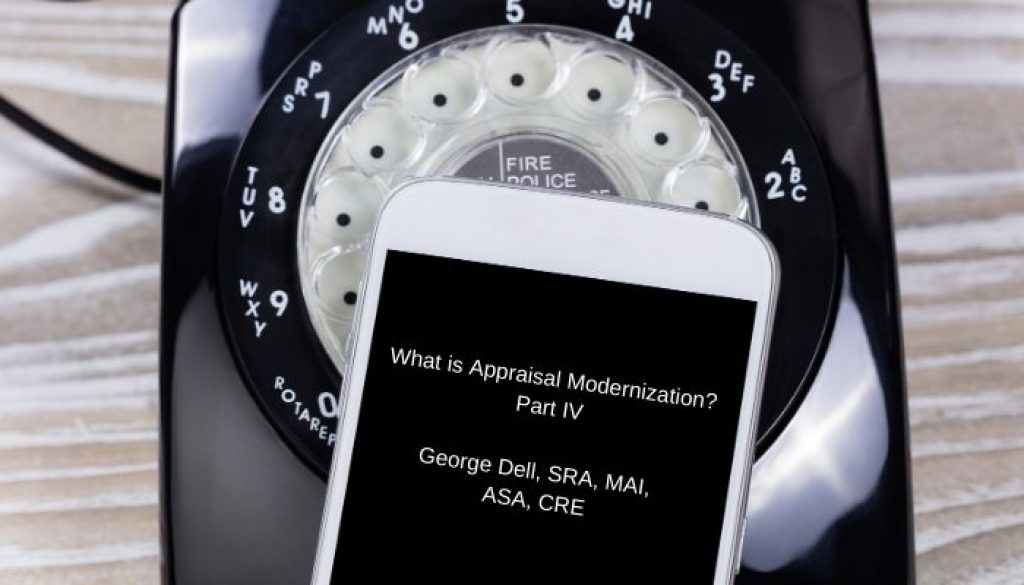In Part IV, we continue our quest for modernization of appraisal.
In Part I, we clarified that an appraisal is an opinion. We figured out that opinions don’t modernize well! We also saw that market price may or may not be true value. And that clients of all types need more than a historic point value. The conclusion was that any solution would require both new education and new software.
In Part II, we learned that an opinion is “not the result of scientific analysis.” Any new education will have to focus on analytic results, not subjective opinion. Any new software will ideally get away from the mental and visual restrictions of the past. Spreadsheet rectangles and canned forms are no match to today’s computer clout and brain-machine synthesis systems.
In Part III, we considered the several distinct replacements for appraisals. Each of these are regulatory work-arounds, but try to address the real need: risk/reliability assessment. Each of these “alternative products” tend toward analytical results, rather than professional opinion. Finally, and most tellingly, we see the impossibility of measuring “credibility,” defined as worthiness of belief. Then a review is an opinion of the worthiness of an opinion – which itself must demonstrate worthiness . . .
In this Part IV, we consider the parallels of the “great recession” of the late 2000’s and the economic interruption from the Covid-19 pandemic. (As they may relate to real property prices.)
Two things stand out. First is the underlying simplicity of the root cause. From the mid-1990s to 2006, prices increased at an increasing rate. The root cause was basic. People were not buying houses for a place to live. They were buying homes to get rich. The HABU (Highest and Best Use) was not fundamental value as a home. And the speculative aspect was subsidized. Mortgage loans matched or exceeded any reasonable future expectations of secured value. Most of the risk fell on the buyer of the loan, then redistributed to taxpayer citizens through the “bail-out.” Effectively, economic risk was ignored. The core problem, the ultimate protection against loss, was the lack of fundamental value in the collateral — the loss being triggered by people’s inability/resistance to continue paying for an overpriced asset. Real value, not pumped up ‘market’ price.
In 2020, the immediate cause is also simple. It is a virus. Physical distancing and closed businesses. Once again, the trade-off is future risk and future cost, against feel-good, look-good today remedies. Some may help, but at what cost? Risk can be measured and estimated. Integrated forecasting is available. The systems are not. Again there is: 1) the sparring between intuitive judgment, and 2) evidence-based public health knowledge.
There is a parallel. Evidence-based medicine (public health), versus more difficult, perhaps “intuitive” political decisions. Evidence Based Valuation (EBV)© versus “trust me” “trust my opinion” appraisal. The real solution requires a mutual understanding of the value of each.
So what might the new goals of modernized asset assessment look like?
- It would have to be not an opinion, but an analytic result.
- It would require emphasis on needs for risk and reliability.
- It would need to be the result of systematic scientific analysis.
- It would require some unlearning of old habits and approaches.
- It would have to blend human competence and computer power.
Our comprehensive, blended result can bring us more – than the best of each taken separately.

April 22, 2020 @ 5:20 pm
I’d take issue with the notion that prior to the Great Recession people were buying homes just to get rich (speculation). Some likely were, but many buyers were legit, they just based their purchase decision on whether they could afford the loan payments – and the mortgage industry accommodated by creating more and more aggressive loan products with lower payments. Anyone who was paying attention could see that the growing spread between real estate prices and income levels was a recipe for eventual disaster.
In order for a modern asset assessment to comply with USPAP, the notion of value as an opinion would have to change. A change like this won’t come easy. And maybe we should continue to accept opinions of value as legit. An analytical result using solid data should still be adopted by the appraiser/valuer has his or her opinion; after all, different valuers might define the market differently (different data) and/or use different valuation techniques (or different assumptions), which would lead to different analytical results. We need to recognize that pretty much nothing in real estate valuation is analytically exact, which is why it is still important to have valuation opinions, albeit opinions that are grounded in solid data and appropriate analysis.